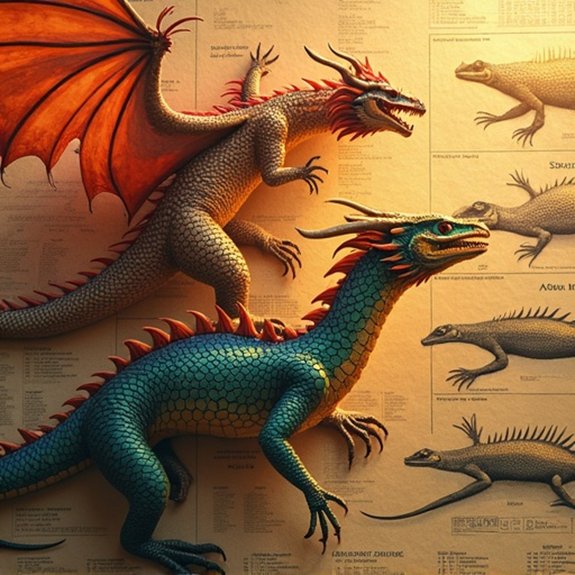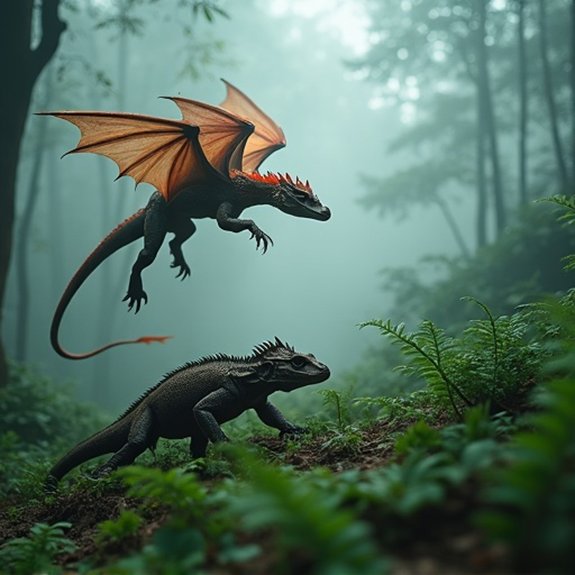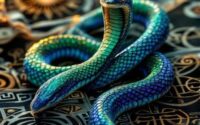Dragons in Myth Vs Zoology
Dragons’ve sparked debates between believers and skeptics for millennia. Scientists dismiss them as pure fantasy while others point to uncanny similarities across unconnected cultures. Ancient texts describe encounters that modern zoologists can’t fully explain. The Mesopotamian goddess Tiamat—part dragon, part primordial chaos—emerged thousands of years before similar creatures appeared in Chinese and European lore. What real animals or discoveries inspired these persistent legends that refuse to die?
Introduction

While dragons have captivated human imagination for millennia, they’ve existed in two distinct domains: the mythological world of legends and the scientific pursuit of real creatures that might’ve inspired these tales. Ancient civilizations from China to Europe independently developed dragon myths, suggesting a universal human fascination with these powerful beasts. They’ve appeared as divine symbols, destructive forces, and wise guardians across cultures.
Meanwhile, zoologists and paleontologists have investigated whether real animals sparked these myths. Some scientists point to crocodiles, monitor lizards, or dinosaur fossils as potential sources. Others argue that dragons represent humanity’s primal fears combined into one creature. This intersection between mythology and zoology reveals how humans interpret nature through storytelling while science attempts to trace legends back to observable reality.
Ancient Mesopotamian Tiamat Myths
Among the earliest dragon myths ever recorded, the Babylonian goddess Tiamat emerged as a primordial force of chaos in Mesopotamian creation stories dating back to 1750 BCE. She’s depicted in the Enuma Elish as a massive serpentine creature embodying primeval saltwater. When younger gods disturbed her peace, Tiamat created an army of monsters and dragons for revenge.
The hero-god Marduk ultimately slayed her, splitting her corpse to form heaven and earth. This battle established the archetypal dragon-slaying narrative that’d influence countless cultures. Tiamat’s representation varied—sometimes she appeared as a multi-headed hydra, other times as a sea serpent with wings and claws. Her myth demonstrates how ancient civilizations used dragon imagery to explain natural phenomena and cosmic order through divine conflict.
Notable Cases or Sightings

The mythological foundations of dragons like Tiamat have sparked centuries of alleged real-world encounters that blur the line between legend and potential zoological discovery. Medieval chronicles document numerous dragon sightings across Europe, including the 1405 encounter near Lucerne, Switzerland, where witnesses claimed they’d seen a wingless serpent emerge from a cave.
China’s historical records detail the 1917 sighting in Yingkou, where thousands reportedly observed a dragon-like creature’s remains. Marco Polo’s journals describe living dragons in Central Asia’s Karakoram Mountains. More recently, Papua New Guinea’s Ropen has generated reports since the 1990s of a bioluminescent, pterosaur-like creature locals call a dragon.
While scientists attribute these accounts to misidentified animals, atmospheric phenomena, or folklore embellishment, the consistency of witness descriptions across cultures continues to fuel cryptozoological investigations.
Common Theories or Explanations
Scientists have proposed several compelling explanations for humanity’s universal dragon mythology, each attempting to decode why these creatures appear across isolated cultures. The fossil discovery theory suggests ancient peoples found dinosaur bones and reconstructed fearsome creatures from incomplete skeletons. They’d have imagined flesh covering these massive frames, creating dragon-like beasts.
Evolutionary psychology offers another angle. Humans evolved fearing three primary predators: snakes, large cats, and raptors. Dragons combine these threats—serpentine bodies, feline movements, and wings—representing humanity’s ultimate nightmare predator.
Some researchers point to real animals. Monitor lizards, crocodiles, and pythons could’ve inspired exaggerated tales. The Komodo dragon wasn’t scientifically documented until 1910, proving large reptilian predators existed beyond Western knowledge. These theories aren’t mutually exclusive; dragon myths likely arose from multiple sources converging in human consciousness.
Frequently Asked Questions
How Do Dragon Depictions Vary Between Eastern and Western Cultures?
Western cultures typically portray dragons as evil, fire-breathing beasts with wings that hoard treasure and terrorize villages. Eastern cultures depict them as benevolent, wise serpentine creatures without wings that control water and bring good fortune.
What Real Animals Might Have Inspired Dragon Myths?
Scientists believe dragon myths weren’t inspired by single animals but combinations of creatures humans feared. They’ve identified crocodiles, large snakes, monitor lizards, and fossil discoveries of dinosaurs and prehistoric mammals as likely sources for these legends.
Are There Any Living Creatures With Dragon-Like Characteristics?
Yes, several creatures display dragon-like traits. Komodo dragons possess impressive size and venomous bites. Flying lizards glide between trees. Frilled lizards extend neck frills defensively. Marine iguanas breathe salt spray that resembles smoke from their nostrils.
How Have Dragons Influenced Modern Fantasy Literature and Media?
Dragons’ve profoundly shaped modern fantasy literature and media, establishing archetypal creatures that authors and filmmakers constantly reimagine. They’ve become central figures in franchises like Game of Thrones, The Hobbit, and countless video games worldwide.
What Role Did Dragons Play in Medieval European Heraldry?
Dragons served as powerful heraldic symbols representing strength, courage, and nobility in medieval European coats of arms. They’d appear as supporters, crests, or charges, particularly favored by Welsh nobility and military orders seeking to project authority.


